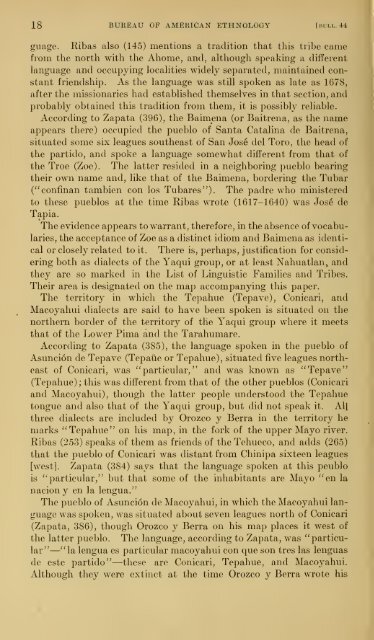Untitled - Smithsonian Institution
Untitled - Smithsonian Institution
Untitled - Smithsonian Institution
You also want an ePaper? Increase the reach of your titles
YUMPU automatically turns print PDFs into web optimized ePapers that Google loves.
18 BUREAU OF AMERICAN ETHNOLOGY [bull. 44<br />
guage. Ribas also (145) mentions a tradition that this tribe came<br />
from the north with the Ahome, and, although speaking a different<br />
language and occupying localities widely separated, maintained con-<br />
stant friendship. As the language was still spoken as late as 1678,<br />
after the missionaries had established themselves in that section, and<br />
probably obtained this tradition from them, it is possibly reliable.<br />
According to Zapata (396), the Baimena (or Baitrena, as the name<br />
appears there) occupied the pueblo of Santa Catalina de Baitrena,<br />
situated some six leagues southeast of San Jose del Toro, the head of<br />
the partido, and spoke a language somewhat different from that of<br />
the Troe (Zoe). The latter resided in a neighboring pueblo bearing<br />
their own name and, like that of the Baimena, bordering the Tubar<br />
("confinan tambien con los Tubares"). The padre who ministered<br />
to these pueblos at the time Ribas wrote (1617-1640) was Jose de<br />
Tapia.<br />
The evidence appears to warrant, therefore, in the absence of vocabu-<br />
laries, the acceptance of Zoe as a distinct idiom and Baimena as identi-<br />
cal or closely related to it. There is, perhaps, justification for considering<br />
both as dialects of the Yaqui group, or at least Nahuatlan„ and<br />
they are so marked in the List of Linguistic Families and Tribes.<br />
Their area is designated on the map accompanying this paper.<br />
The territory in which the Tepahue (Tepave), Conicari, and<br />
Macoyahui dialects are said to have been spoken is situated on the<br />
northern border of the territory of the Yaqui group where it meets<br />
that of the Lower Pima and the Tarahumare.<br />
According to Zapata (385), the language spoken in the pueblo of<br />
Asuncion de Tepave (Tepaiie or Tepahue), situated five leagues northeast<br />
of Conicari, was "particular," and was known as "Tepave"<br />
(Tepahue) ; this was different from that of the other pueblos (Conicari<br />
and Macoyahui), though the latter people understood the Tepahue<br />
tongue and also that of the Yaqui group, but did not speak it. All<br />
three dialects are included by Orozco y Berra in the territory he<br />
marks "Tepahue" on his map, in the fork of the upper Mayo river.<br />
Ribas (253) speaks of them as friends of the Tehueco, and adds (265)<br />
that the pueblo of Conicari was distant from Chinipa sixteen leagues<br />
[west]. Zapata (384) says that the language spoken at this peublo<br />
is "particular," but that some of the inhabitants are Mayo "en la<br />
nacion y en la lengua."<br />
The pueblo of Asuncion de Macoyahui, in which the Macoyahui language<br />
was spoken, was situated about seven leagues north of Conicari<br />
(Zapata, 386), though Orozco y Berra on his map places it west of<br />
the latter pueblo. The language, according to Zapata, was "particular"—<br />
"la lengua es particular macoyahui con que son tres las lenguas<br />
de este partido"—these are Conicari, Tepahue, and Macoyahui.<br />
Although they were extinct at the time Orozco y Berra wrote his

















